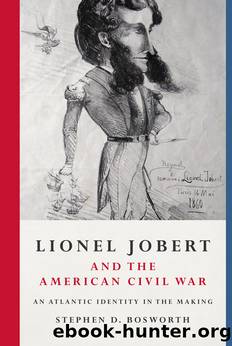Lionel Jobert and the American Civil War by Stephen D. Bosworth

Author:Stephen D. Bosworth [Bosworth, Stephen D.]
Language: eng
Format: epub
Tags: Biography & Autobiography, Military, History, United States, 19th Century
ISBN: 9781438485119
Google: 6j06EAAAQBAJ
Publisher: SUNY Press
Published: 2021-09-01T02:42:18+00:00
Chapter 7
The Count and Countess dâEpineuil
London-based A. Lynes and Son, merchant clothiers and outfitters, published a series of seasonal brochures showcasing their clothing lines and included short stories in the brochures to make them more attractive to the public. Their summer 1871 issue, Wit and Wear, presented a story called âThe Naked Truth.â The storyâs protagonist, Simon Fluffywick, repeatedly fell victim in his youth to those who sought to take advantage of him. Such incidents affected the mature Simon to the degree that âIf telling a falsehood served his ends better than telling the truth, or saved him trouble, he invariably shut the door at truth, and opened the window for falsehood to enter.â In a dream, a fairy came and cast a spell to make Simon tell the truth. He did so, but tactlessly, insulting friends and acquaintances and airing their skeletons in public. His wife had him committed to an asylum, âHopeless House,â when a doctor certified him as insane. The fairy eventually returned in another dream and lifted the spell, admonishing Simon to be delicate when telling the truth. After his release from the asylum, âSimon made himself the most agreeable host that ever livedâ at a welcome back party thrown by the friends he had insulted.1 Simon made himself be agreeable; it was an act. The message of the tale is that falsehoods and semitruthsâsuch as things we say to be polite instead of what we are really thinkingâare a common part of human social relations; how one manages such interaction is a measure of oneâs character.
The author of âThe Naked Truthâ was Sir Horatio Henry Wraxall, a British baronet and writer of light literature. Wraxall was Lionel Jobertâs contemporary, just two years younger than Jobert. Also like Jobert, the titled Wraxall had a maritime background, having started as a teenage apprentice merchant navy seaman in 1845. Performing in theatrical productions served as Jobertâs artistic escape and writing was Wraxallâs. Jobert and Wraxall proved adept at truth-bending when it served their needs, just like Wraxallâs character Simon Fluffywick. And perhaps most significantly, both men faced the decade of the 1870s in financial distress: Jobert fleeing debt obligations in the United States and Wraxall squandering his wealth by betting unsuccessfully on horse racing.2 Comparing the latter to dâEpineuil shows us two facets of nineteenth-century Atlantic history. One is that the era had its share of confidence men and opportunists; men like them were not outliers, but rather representative of a subset of the population who cared more about personal advancement than about the great issues of the day. Another is that Jobertâs mobility around the Atlantic region allowed him to evade the more severe consequences of misleading the authorities and acting against the law, whereas Wraxallâs permanence in Great Britain allowed government officials to contain him more effectively.
When St. Edme Jobert died late in the spring of 1861, his first child Clémence and her husband Edmond Breuil were living in Civitavecchia in the Papal States where Breuil served as French consul first class.
Download
This site does not store any files on its server. We only index and link to content provided by other sites. Please contact the content providers to delete copyright contents if any and email us, we'll remove relevant links or contents immediately.
Harry Potter and the Goblet Of Fire by J.K. Rowling(3077)
Unfinished: A Memoir by Priyanka Chopra Jonas(2918)
Never by Ken Follett(2906)
Machine Learning at Scale with H2O by Gregory Keys | David Whiting(2316)
The Man Who Died Twice by Richard Osman(2307)
Fairy Tale by Stephen King(2090)
Will by Will Smith(2061)
Rationality by Steven Pinker(1773)
The Storyteller by Dave Grohl(1667)
The Dark Hours by Michael Connelly(1579)
The Dawn of Everything: A New History of Humanity by David Graeber & David Wengrow(1577)
The Stranger in the Lifeboat by Mitch Albom(1548)
Cloud Cuckoo Land by Anthony Doerr(1446)
New Morning Mercies: A Daily Gospel Devotional by Paul David Tripp(1373)
Friends, Lovers, and the Big Terrible Thing by Matthew Perry(1342)
The Becoming by Nora Roberts(1337)
Crying in H Mart by Michelle Zauner(1329)
Einstein: His Life and Universe by Walter Isaacson(1320)
A Short History of War by Jeremy Black(1304)
